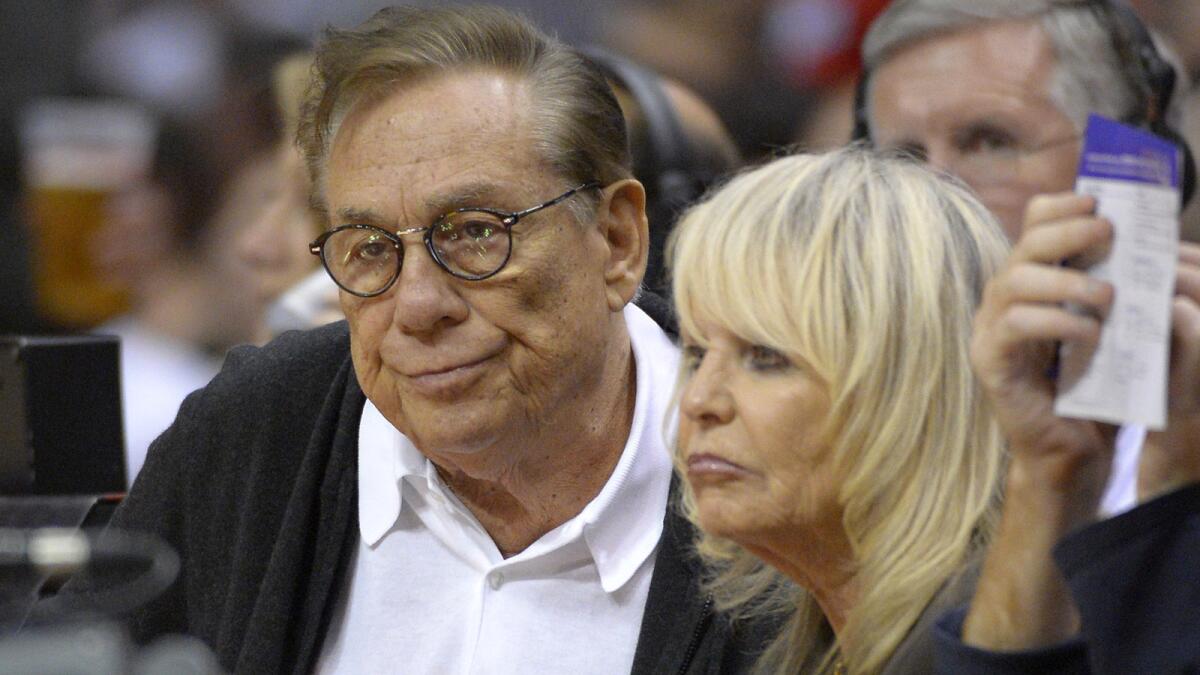Sterling foundation ads tout good works, but verifying them isn’t easy

The publicity campaign promised a new summer program at Point Dume for poor children, funded in part by the Donald T. Sterling Charitable Foundation.
A smiling Sterling was shown next to a horse in some newspaper ads. In others, the foundation described the project as “the 20 Acre Malibu Farm & Horse Ranch Estate As A Free Summer Camp For Underprivileged Kids Ages 6-14.”
Initially the camp was to open in 2014, offering horseback riding, golf, a new pool and tennis court, even a heli-pad; more recently, advertisements said it would debut in 2016.
But Malibu officials said Sterling has filed no proposals with the city for the project. And Darren Schield, the Sterling foundation’s chief financial officer, said he had no information about plans to fund the Malibu ranch. Sterling did not respond to requests for comment.
Ads bearing the name of the Sterling Foundation have heavily promoted its namesake’s good works. Those in the Los Angeles Times have featured pictures of the billionaire Clippers owner and numerous recipients of his largesse, including leaders of groups that serve minorities and the underprivileged.
Some of the ads said the foundation was committed to making $10 million in donations. Others cited larger figures — $17 million, even $20 million.
The foundation’s actual giving has been far more modest than the publicity suggests.
And some of Sterling’s most touted projects, such as the Malibu children’s camp and earlier plans for a skid row homeless center, have so far failed to materialize.
From 2009, when Sterling began funding the foundation, through the end of 2012, it gave out about $1.4 million, according to tax records.
Most were grants of $5,000 to $20,000 to dozens of community groups and schools, including Para Los Niños, the United Negro College Fund and the Union Rescue Mission.
Some organizations that received the foundation’s money said they were grateful. But others said they became turned off by what they considered Sterling’s relentless self-promotion, even before the NBA banned the Clippers owner for life last week for a recording in which a man the league said was Sterling told a female friend not to associate with black people in public.
Sterling, whose estimated net worth is $1.9 billion, began funding the charity the same year he paid $2.7 million to settle a federal housing discrimination lawsuit. Sterling, whose company owns numerous apartment buildings across Southern California, has been dogged by allegations in lawsuits that he refused to rent to African Americans, Latinos and families with children.
Among the recipients of Sterling’s charitable money was 100 Black Men of Los Angeles, a youth mentoring program that received $5,000 in 2009. Some members said in interviews that they were initially hesitant to take the money after hearing about the housing discrimination allegations against Sterling, but they decided it was more important to provide scholarships to disadvantaged students.
Soon a photo of the organization’s then-president began appearing in newspaper advertisements. Group members were disturbed by what they saw as the message: “Look at all the African Americans I’m helping,” said the group’s current president, Pastor Jewett Walker Jr.
Walker said the organization asked Sterling to stop using its name and logo in the ads, but the request was ignored. Then the group heard that former Clippers general manager Elgin Baylor, a Hall of Fame NBA player, had sued Sterling for wrongful termination and had accused him of fostering a “plantation mentality” in the Clippers organization. (Baylor later dropped the racial-bias claim.)
Walker said 100 Black Men returned the money and sent a cease-and-desist letter demanding that Sterling stop using its name and logo in the ads.
“I think he was pimping us to get credit for helping the African American community,” he added.
Times spokeswoman Nancy Sullivan said in a statement that “it is the advertiser’s responsibility to secure permissions from any person whose image is utilized in their advertising.”
In another case, the Sterling foundation pledged $10,000 annually for 10 years to A Place Called Home, a nonprofit organization for disadvantaged children in South Los Angeles, according to tax records.
“Suddenly, my picture showed up in the L.A. Times in those ads,” said Jonathan Zeichner, the group’s executive director. He said he did not recall giving the foundation permission to use his image in the ads.
“Once a year I would go to a luncheon where he dispensed the checks.”
Like many who received the money, Zeichner said he was shocked by the recording released last week. He said it crystallized his feeling that the foundation’s giving was intended to boost Sterling’s image.
“We were a bit of a beard for him.” he said. “Clearly those ads are about letting people know he is a good guy.”
Schield, the foundation’s chief financial officer, said the charity did not pay for the newspaper ads and had nothing to do with their content.
“I can’t comment on those,” he said.
The Times’ Sullivan declined to provide details about the ads, saying it was company policy not to disclose information about advertisers.
It’s difficult to determine definitively how much Sterling has given to charities overall. It is possible that Sterling has made charitable contributions as an individual — rather than through his foundation — that would not appear in the foundation’s public tax filings.
Schield said he assumes that Sterling has made personal donations to charities and has given money over the years to the separate Los Angeles Clippers Foundation.
He cited as one example of Sterling’s personal philanthropy a $425,000 donation in 2013 to UCLA for kidney research. The university said it was to be the first installment of a $3-million pledge to be paid over seven years. UCLA returned the money and canceled the pledge after the furor erupted over Sterling’s recorded comments.
But it was the work of the foundation that Sterling heavily promoted.
Schield said the organization has yet to file its 2013 tax return but believed it would show an increase in giving over previous years.
Some of the Sterling foundation ads from 2012 said the group was committed to making $10 million in donations.
More recently, ads have said the foundation was committed to spending $17 million. Other ads listed the total as $20 million.
It is possible the larger sums reflect, at least in part, pledges of future giving as well as donations actually made. Zeichner said that in the case of his children’s charity, the foundation appeared to count the entire commitment — $10,000 a year for 10 years — as one lump sum for publicity purposes, even though only a fraction of that has been disbursed.
Sterling’s now-abandoned interest in funding a skid row homeless center reflects both the pomp and the uncertainty that surrounds his charitable activities.
About six years ago, newspaper ads started appearing saying that Sterling wanted to build a homeless center in downtown Los Angeles. Andy Bales, chief executive officer of the Union Rescue Mission, said Sterling talked to skid row nonprofits about helping him raise $50 million for a Donald Sterling Homeless Center. Bales and other officials on skid row thought the idea unrealistic, and Sterling eventually dropped it.
Still, Bales said, his organization appreciates the money it has received from the Sterling foundation — $20,000 through 2012, according to tax records.
“We keep doing good with whatever revenue we get from sometimes imperfect people,” Bales added. He said he was disturbed by Sterling’s comments but “we wouldn’t want to rob Mr. Sterling of the good he has done in the past.”
The foundation’s latest tax return says its officers are Sterling, his wife Rochelle, Schield and lawyer Douglas Walton. In some of the ads, V. Stiviano, the woman whose audio recording set off the scandal, is identified in photo captions as a member of the foundation. In others, she’s identified as a representative of Catholic Charities or Our Lady of Angels.
The Clippers have a separate foundation that was incorporated in 1994. Sterling’s involvement with it could not be determined from its tax filings, but his foundation gave it $10,000 in 2009.
In fiscal 2011-12, the Clippers foundation had net assets of nearly $1.2 million and spent about $633,000 on its charitable programs, including grants to groups such as Feed the Children Inc. and the Special Olympics of Southern California, according to its most recently available tax return.
It’s run by a board made up of Clippers employees, according to tax records. In some of the ads for the Malibu youth camp, the Clippers foundation is listed as a co-sponsor.
Charity watchdogs say Sterling’s penchant for advertising his philanthropic efforts is unusual.
“He is somewhat unique in how much he’s bragging about his philanthropy,” said Ken Berger, president of Charity Navigator, an online evaluator of nonprofit groups. “He’s shouting from the rooftops, ‘Look how generous I am!’ ”
Times staff writers Richard Winton, Nathan Fenno, Larry Gordon and Ryan Menezes contributed to this report.
More to Read
Sign up for Essential California
The most important California stories and recommendations in your inbox every morning.
You may occasionally receive promotional content from the Los Angeles Times.












